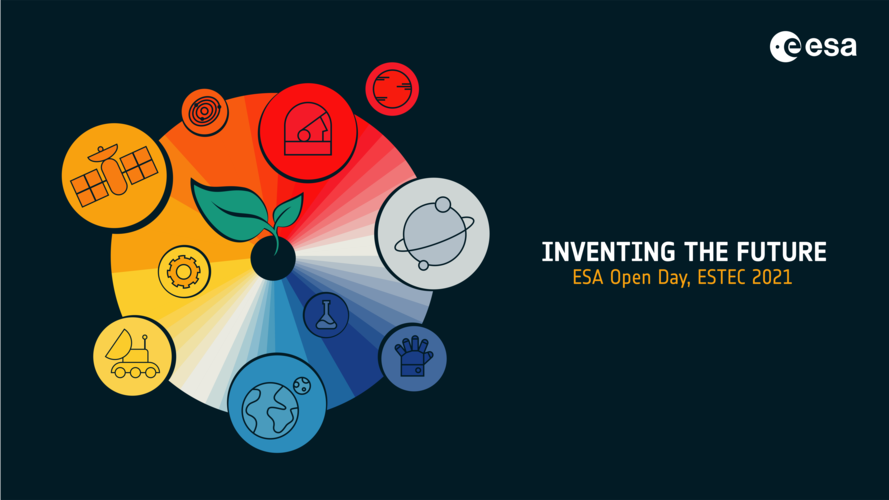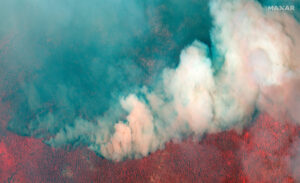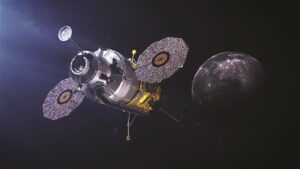NASA's Perseverance rover collects first rock sample
Tuesday, 07 September 2021 08:37 NASA's Perseverance rover has completed the collection of the first sample of Martian rock, a core from Jezero Crater slightly thicker than a pencil. Mission controllers at NASA's Jet Propulsion Laboratory (JPL) in Southern California received data that confirmed the historic milestone.
The core is now enclosed in an airtight titanium sample tube, making it available for retrieval in the f
NASA's Perseverance rover has completed the collection of the first sample of Martian rock, a core from Jezero Crater slightly thicker than a pencil. Mission controllers at NASA's Jet Propulsion Laboratory (JPL) in Southern California received data that confirmed the historic milestone.
The core is now enclosed in an airtight titanium sample tube, making it available for retrieval in the f NASA begins air taxi flight testing with Joby
Tuesday, 07 September 2021 08:37 NASA began flight testing Monday with Joby Aviation's all-electric vertical takeoff and landing (eVTOL) aircraft as part of the agency's Advanced Air Mobility (AAM) National Campaign. This testing runs through Friday, Sept.10, at Joby's Electric Flight Base located near Big Sur, California. This is the first time NASA will test an eVTOL aircraft as part of the campaign. In the future, eVTOL airc
NASA began flight testing Monday with Joby Aviation's all-electric vertical takeoff and landing (eVTOL) aircraft as part of the agency's Advanced Air Mobility (AAM) National Campaign. This testing runs through Friday, Sept.10, at Joby's Electric Flight Base located near Big Sur, California. This is the first time NASA will test an eVTOL aircraft as part of the campaign. In the future, eVTOL airc Protective equipment against radiation to be tested on Nauka Module on ISS in 2023
Tuesday, 07 September 2021 08:37 New equipment that will help protect people from radiation during interplanetary flights will be tested on the Russian Nauka multipurpose laboratory module at the International Space Station, the head of the nuclear planetology department at the Space Research Institute of the Russian Academy of Sciences, Igor Mitrofanov, said.
"We are wrapping up the construction of a design and developme
New equipment that will help protect people from radiation during interplanetary flights will be tested on the Russian Nauka multipurpose laboratory module at the International Space Station, the head of the nuclear planetology department at the Space Research Institute of the Russian Academy of Sciences, Igor Mitrofanov, said.
"We are wrapping up the construction of a design and developme NASA confirms Perseverance Mars rover got its first piece of rock
Tuesday, 07 September 2021 08:37 NASA confirmed Monday that its Perseverance Mars rover succeeded in collecting its first rock sample for scientists to pore over when a future mission eventually brings it back to Earth.
"I've got it!" the space agency tweeted, alongside a photograph of a rock core slightly thicker than a pencil inside a sample tube.
The sample was collected on September 1, but NASA was initially unsure
NASA confirmed Monday that its Perseverance Mars rover succeeded in collecting its first rock sample for scientists to pore over when a future mission eventually brings it back to Earth.
"I've got it!" the space agency tweeted, alongside a photograph of a rock core slightly thicker than a pencil inside a sample tube.
The sample was collected on September 1, but NASA was initially unsure Astronomers explain origin of elusive ultradiffuse galaxies
Tuesday, 07 September 2021 08:37 As their name suggests, ultradiffuse galaxies, or UDGs, are dwarf galaxies whose stars are spread out over a vast region, resulting in extremely low surface brightness, making them very difficult to detect. Several questions about UDGs remain unanswered: How did these dwarfs end up so extended? Are their dark matter halos - the halos of invisible matter surrounding the galaxies - special?
As their name suggests, ultradiffuse galaxies, or UDGs, are dwarf galaxies whose stars are spread out over a vast region, resulting in extremely low surface brightness, making them very difficult to detect. Several questions about UDGs remain unanswered: How did these dwarfs end up so extended? Are their dark matter halos - the halos of invisible matter surrounding the galaxies - special? Hubble discovers hydrogen-burning white dwarfs enjoying slow aging
Tuesday, 07 September 2021 08:37 Could dying stars hold the secret to looking younger? New evidence from NASA's Hubble Space Telescope suggests that white dwarf stars could continue to burn hydrogen in the final stages of their lives, causing them to appear more youthful than they actually are. This discovery could have consequences for how astronomers measure the ages of star clusters, which contain the oldest known stars in t
Could dying stars hold the secret to looking younger? New evidence from NASA's Hubble Space Telescope suggests that white dwarf stars could continue to burn hydrogen in the final stages of their lives, causing them to appear more youthful than they actually are. This discovery could have consequences for how astronomers measure the ages of star clusters, which contain the oldest known stars in t Astronomers nail down the origins of rare loner dwarf galaxies
Tuesday, 07 September 2021 08:37 By definition, dwarf galaxies are small and dim, with just a fraction of the stars found in the Milky Way and other galaxies. There are, however, giants among the dwarfs: Ultra-diffuse galaxies, or UDGs, are dwarf systems that contain relatively few stars but are scattered over vast regions. Because they are so diffuse, these systems are difficult to detect, though most have been found tucked wi
By definition, dwarf galaxies are small and dim, with just a fraction of the stars found in the Milky Way and other galaxies. There are, however, giants among the dwarfs: Ultra-diffuse galaxies, or UDGs, are dwarf systems that contain relatively few stars but are scattered over vast regions. Because they are so diffuse, these systems are difficult to detect, though most have been found tucked wi ISRO developing microbe cultivation device for orbital biological experiments
Tuesday, 07 September 2021 08:37 According to state scientific representatives, India's space agency (ISRO) must identify indigenous solutions to achieve its ambitious space program. Researchers also state that the device has separate compartments that can conduct different kinds of experiments.
Scientific representatives from one of India's premiere institutes, the Indian Institute of Science (IISc), partnering with the
According to state scientific representatives, India's space agency (ISRO) must identify indigenous solutions to achieve its ambitious space program. Researchers also state that the device has separate compartments that can conduct different kinds of experiments.
Scientific representatives from one of India's premiere institutes, the Indian Institute of Science (IISc), partnering with the AFRL offers university satellite program
Tuesday, 07 September 2021 08:37 The Air Force Research Laboratory's University Nanosatellite Program (UNP) request for proposals (RFP) will be open until October 1. UNP funds U.S. university students and programs to design, build, launch, and operate small satellites with the primary goal to train the next generation of space professionals.
"For more than 20 years, UNP has equipped thousands of students across the countr
The Air Force Research Laboratory's University Nanosatellite Program (UNP) request for proposals (RFP) will be open until October 1. UNP funds U.S. university students and programs to design, build, launch, and operate small satellites with the primary goal to train the next generation of space professionals.
"For more than 20 years, UNP has equipped thousands of students across the countr Scientists are using new satellite tech to find glow-in-the-dark milky seas of maritime lore
Tuesday, 07 September 2021 08:37 For centuries, sailors have been reporting strange encounters like the one above. These events are called milky seas. They are a rare nocturnal phenomenon in which the ocean's surface emits a steady bright glow. They can cover thousands of square miles and, thanks to the colorful accounts of 19th-century mariners like Capt. Kingman, milky seas are a well-known part of maritime folklore. But beca
For centuries, sailors have been reporting strange encounters like the one above. These events are called milky seas. They are a rare nocturnal phenomenon in which the ocean's surface emits a steady bright glow. They can cover thousands of square miles and, thanks to the colorful accounts of 19th-century mariners like Capt. Kingman, milky seas are a well-known part of maritime folklore. But beca The first cells might have used temperature to divide
Tuesday, 07 September 2021 08:37 A simple mechanism could underlie the growth and self-replication of protocells-putative ancestors of modern living cells-suggests a study publishing September 3 in Biophysical Journal. Protocells are vesicles bounded by a membrane bilayer and are potentially similar to the first unicellular common ancestor (FUCA). On the basis of relatively simple mathematical principles, the proposed model sug
A simple mechanism could underlie the growth and self-replication of protocells-putative ancestors of modern living cells-suggests a study publishing September 3 in Biophysical Journal. Protocells are vesicles bounded by a membrane bilayer and are potentially similar to the first unicellular common ancestor (FUCA). On the basis of relatively simple mathematical principles, the proposed model sug ESA Open Day invites people with disabilities – plus virtual event for all
Tuesday, 07 September 2021 08:05
The tenth annual ESA Open Day is confirmed for the weekend of 2-3 October. A combination of in-person and virtual events, this is your chance to meet Europe’s astronauts and space experts and see spacecraft, hardware and test equipment in close-up. On Saturday people with disabilities will have a special chance to tour ESA’s ESTEC technical centre in the Netherlands, while the following day’s virtual event will be open to all.
DoD to extend intelligence agency program that helps track wildfires
Monday, 06 September 2021 17:06
The Pentagon announced Sept. 3 it plans to extend a pilot program that provides imagery from satellites, drones, ground sensors and cameras to help track and combat wildfires.
House budget reconciliation package funds NASA infrastructure but not lunar lander work
Monday, 06 September 2021 16:17
The House Science Committee will mark up its portion of a multitrillion-dollar spending bill this week that includes several billion dollars for NASA infrastructure but nothing for lunar lander development.
Science, student payloads fly aboard NASA's scientific balloons during fall campaign
Monday, 06 September 2021 10:54
NASA's Scientific Balloon Program's 2021 fall campaign is now underway in Fort Sumner, New Mexico, launching the first three of eight missions in August.
The missions planned for this campaign include an annual student experiment, three missions from NASA's Jet Propulsion Laboratory (JPL), and technology demonstrations for NASA's Columbia Scientific Balloon Facility.
The campaign window opened in mid-August and will run through mid-October.
"After a successful spring campaign, we hope to continue that success into our fall campaign," said Debbie Fairbrother, Scientific Balloon Program Office chief at NASA's Wallops Flight Facility in Virginia. "These flights continue to not only be important to our university and NASA partners, but to the next generation who get a hands-on experience building and flying their experiments aboard a real science platform.

